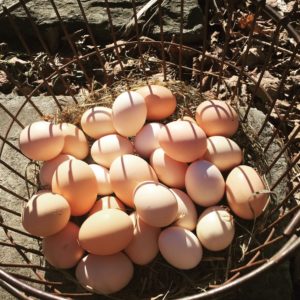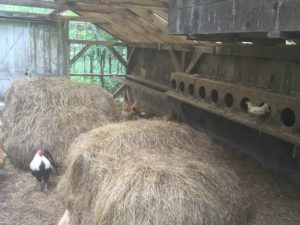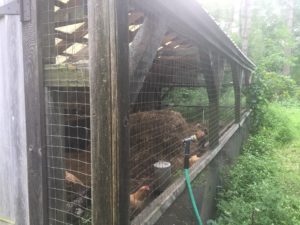Healthy Chickens=Healthy Profits
 Healthy chickens result from careful planning. Your happy hens will lay eggs regularly which you can turn around and sell for profit. Following are the practices we implement in our flock to encourage optimal health in order to produce the most amount of eggs.
Healthy chickens result from careful planning. Your happy hens will lay eggs regularly which you can turn around and sell for profit. Following are the practices we implement in our flock to encourage optimal health in order to produce the most amount of eggs.
Ways to save money
It can be easy to spend money on your flock. While some purchases are necessary, there are a multitude of ways to save money.
Bedding

The chickens have started to break the bales apart and spread the bedding.
Healthy chickens start with clean, dry bedding. Providing ample amounts of clean bedding saves time and money by helping to keep the eggs clean so you do not have to wash them. This practice keeps eggs fresher for a longer period of time as the bloom is not washed off. Additionally, clean and dry bedding lessens the likelihood of illnesses penetrating your flock. We procure old round bales of hay from local farmers for a cheap price.
The bales will last for several years and the chickens spread the bedding around on their own as they pick the round bales apart. The hay composts through the winter and gives off heat. On especially frigid nights, you may find chickens roosting on the bales to help stave off frostbite.
Feed
We cut down on the amount of grain we feed by collecting our food scraps from meals and feeding the compost to our birds. This adds variety and essential nutrients to their diet. A varied diet also creates healthy chicken manure. Chicken manure can burn plant roots. Therefore, it needs some time to decompose. We collect some of the droppings and allow them to break down in a separate area. This dirt adds depleted nitrogen, phosphorus, and potassium to your own garden, or sell it as a nutrient-rich additive.
Growing your flock

Hatched chicks learn valuable survival skills from their mother.
We save money on buying chicks every year by allowing our hens to set on eggs in the spring and hatch out babies. Chicks are fed with ground oatmeal, bread crumbs, and crushed hard-boiled eggs with the shells. We save money by not purchasing chick crumbles. Plants and soil are provided for the chicks to scratch in. It has been our experience that when livestock is provided with sod to eat, they are often much healthier than animals who go without.
Optimal housing
A coop that encourages healthy chickens can take many forms. The ideas presented here are what we have learned from our years of raising a laying flock.
Coop Floor
A coop with no floor system, in our opinion, is ideal for several reasons. One does not have to clean the coop out after the winter. I have thrown my back out too many times in the past cleaning out a coop after the spring thaw. Exposing your flock to a dirt floor allows them areas to take dust baths for mite control, encourages them to scratch, and allows opportunities to eat soil and pebbles. As mentioned previously, animals raised with sod and soil as part of their diet tend to be healthier as they will eat microbes that encourage a healthy digestive tract. Additionally, chickens eat small pebbles to help grind food in the gizzard.

Part of the roof is covered with chicken wire, the other half is kept dry with roofing.
Shelter and Ventilation
Chicken wire is attached to part of the roof so it is open to rain and snow. This method helps the bedding and other organic material to break down quickly.
We built a box over one roost to provide shelter from winter winds and blowing snow. It is extremely important for a coop to have adequate ventilation. Fresh air helps to keep chickens healthy. Additionally, air flow, even in the winter, reduces humidity buildup which will help to prevent frostbite.
Egg production year-round
From our experience of running a small, profitable egg laying business for several years, to keep hens laying year-round, they need at least 14-16 hours of light a day to prevent molting. A hen’s molt lasts from a few weeks to several months, during which she stops laying eggs as her body needs protein to make new feathers. We never noted a decline in health from preventing a molt, though we do not often keep chickens beyond two years. Hens lay the most amount of eggs between six months and eighteen months old. After that, we slaughter them for the stew pot and rotate in six-month-old pullets that were hatched in the spring.
Keeping healthy chickens through the winter

A board extends the length of the protected winter roost.
Winter in the north-eastern United States is very cold. Consider choosing smaller combed varieties to help prevent frostbite on extremities. Providing the flat side of 2x4s or square roosts allow the chickens to cover their toes with feathers to prevent frostbite on toes. Large, high production varieties like buff Orpington, Wyandotte, and Cochin have successfully over-wintered in our coop. Our flock rarely retreats inside to sleep in the winter months. They roost close together and puff out their feathers to trap body heat.
We do not recommend a heat lamp for the winter as chickens are essentially wearing a down coat. Additionally, the lamps pose dangers such as the potential to fall and catch bedding on fire. As long as birds roost together, are well fed, have fresh water, are provided dry bedding, and have good ventilation, they will survive even the harshest temperatures and emerge healthy chickens come spring.
Sell Your Eggs For Potential Profit

Chicken wire is a useful tool to keep predators out and allow air to circulate.
Raising a flock of chickens can be enjoyable, entertaining, and profitable. If you have enough layers to provide several dozen eggs a day, you can sell the eggs to local stores, and the hens’ work can pay for their grain. If you are lucky, you may have a little extra cash left over.











3 Comments
ground oatmeal, bread crumbs, and crushed hard-boiled eggs with the shells….Would you please give alittle more info on just what line and how it’s mixed?tks
Gregg, I used 2 parts breakfast oatmeal from my pantry, dry; 1 part crumbled up stale bread, 1 crumbled hard-boiled egg per 10 chicks (as they grew, this changed to two hard-boiled eggs per 10 chicks). I fed them this mixture up to 4 times a day if their food dish was empty.
[…] Healthy chickens result from careful planning. Your happy hens will lay eggs regularly which you can turn around and sell for profit. Following are the practices we implement in our flock to encourage optimal health in order to produce the most amount of eggs. homestead.mothere… […]